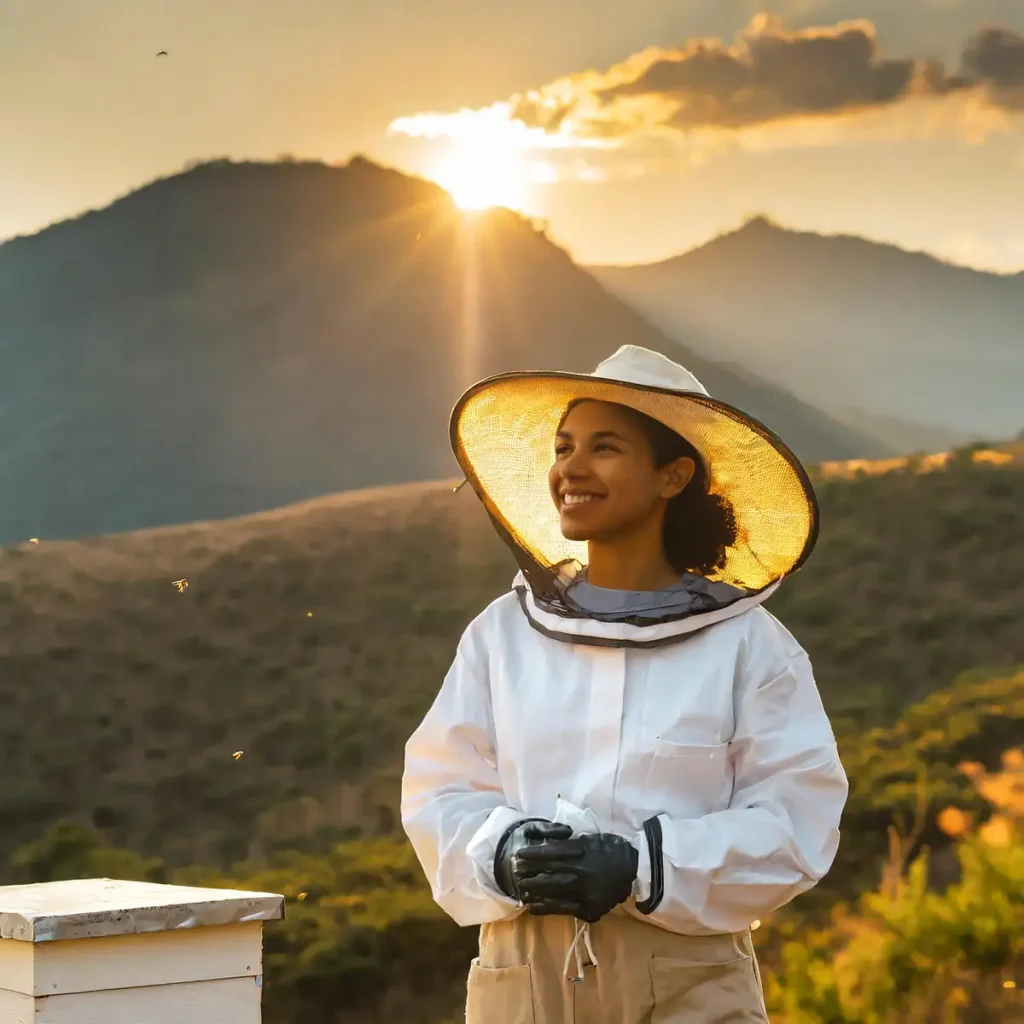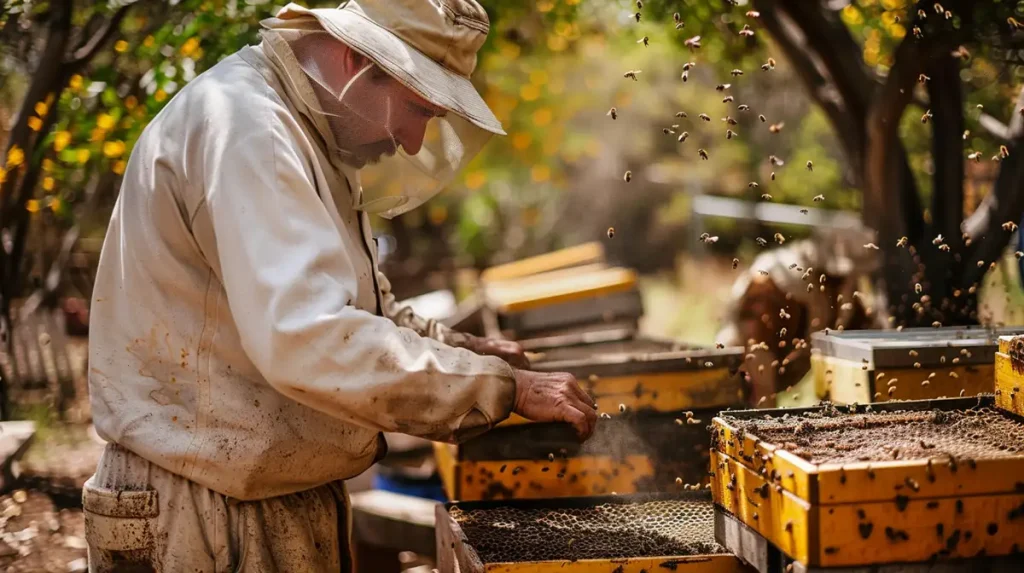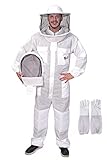Table of Contents
When you come across any beekeeper, he or she will likely be wearing a beekeeping suit consisting of heavy pants, a jacket, gloves, a hat and veil, and heavy boots. Indeed, a beekeeping suit is one of the first things new beekeepers buy along with a basic set of hand tools. Some old-timers may decide they don’t like the hassles of using a suit, but it’s always advised that new beekeepers wear the right kind of protective clothing. You can never be too careful.
Modern beekeeping suits are primarily created from one of the following three different materials:
- Cotton
- Nylon
- Mesh
Materials for Beekeeping Suits
History indicates that beekeeping suits are a relatively new thing by comparison. The ancient Egyptians allegedly kept bees without any protective clothing whatsoever. The first record of a purpose-designed beekeeping suit doesn’t show up until sixteenth century Europe.
Back then, beekeepers wore masks made of wicker, covering the rest of their bodies with a single-piece garment that looked an awful lot like a choir robe. The suits were largely ineffective because the masks were difficult to see through and the robes still left gaping holes through which bees could get in.
The modern beekeeping suit is quite an improvement over what beekeepers used in times past. Three primary materials are used for modern suits:
1. Cotton
Cotton has been the go-to material for a couple of hundred years. It is a thick material that is hard for bee stings to penetrate, and it is naturally white (more on that later). The main problem with cotton is that it isn’t very breathable. You can get extremely warm in a cotton suit during the heat of the summer. You are going to be sweating in all likelihood.
2. Nylon
Nylon would have been unthinkable for a beekeeping suit a few decades ago. It is too thin to offer any kind of resistance to stingers. However, it does have one advantage over cotton that makes it rather effective: bees have a hard time gripping it long enough to settle in and deliver a sting. They tend to slide off before they can complete the job.
Now let’s talk about warmth. Nylon is even less breathable than cotton. That means it’s going to be warmer. It also means you are going to sweat more in a nylon suit. The icing on the cake is that the nylon will stick to your skin for the simple fact that it does not absorb perspiration like cotton does.
3. Mesh
There are some modern beekeeping suits that are made of several layers of mesh material. A single layer doesn’t offer much protection against stings but layering multiple pieces of mesh together creates a surface thick enough to repel most stingers. The obvious benefit is that mesh is breathable.
The downside of mesh is that it is harder to create a quality garment with it. Mesh bee suits do not tend to last as long, and they may not be manufactured with the same level of quality and craftsmanship.
At the end of the day, your biggest concern is preventing stings. If you are not willing to take any chances, your best bet is to go with cotton. It has been the number one choice of beekeepers for a long, long time.

What a Beekeeping Suit Includes
Now that you know what beekeeping suits are made of, let us talk about what constitutes a proper suit. The main body of the suit is made up of pants and a jacket. Where these two pieces were separate in decades past, almost all new beekeeping suits today are one-piece suits. You are essentially buying a pair of thick, cotton coveralls with gathers at the ankles and wrists.
- Carter, Anthony (Author)
- English (Publication Language)
- 194 Pages - 02/28/2024 (Publication Date) - Independently published (Publisher)
Next is the hat and veil. The hat sits on top of the head while the veil falls down around from the brim and gets tucked into the suit. Everything is nicely held together with some sort of fastener, usually either a zipper or Velcro. As for the gathers around the wrists and ankles, these are there to prevent bees from finding a way into the suit. Otherwise, checking your hives could become rather uncomfortable.
Lastly, a beekeeping suit is completed with a pair of thick gloves and heavy work boots. The gloves go up over the wrists and are closed with either a piece of Velcro or a strap and buckle. Boots are generally high enough to rise above the gathers on the ankles. They are also sealed closed with a strap or piece of Velcro.
You will notice that every beekeeping suit available on the retail market is white. Have you ever wondered why? It turns out that dark colors agitate bees. We don’t know why for sure, but scientists have long speculated that dark colors are confusing to bees. If they see a human dressed in dark clothing, they might mistake that person for a bear. Bees and bears don’t get along, so such confusion is not good for the person.
Making Your Own Beekeeping Suit
There are some beekeepers who prefer to make their own suits rather than buy a commercially produced alternative. That is entirely up to you, but beekeeping suits are not terribly expensive. You can get a good suit for somewhere between $100 and $200.
If making your own suit is your thing, there is no need to buy a pattern and make it from scratch. You can use existing clothing that you modify for your purposes. Look for garments made of the heaviest cotton or denim you can find.
You start with a heavy shirt and some Velcro straps. After removing the buttons and sewing all of the button holes closed, you are going to sew Velcro up both edges of the shirt to create a single piece enclosure that replaces the buttons. Then you are going to sew a Velcro strip all the way around the inside of the collar to which will eventually attach the veil of your hat.
You can modify a pair of thick cotton or denim pants in the same way. Sew Velcro strips to the inside of the waistband and the bottom of your shirt so that when the shirt is tucked in, you can create a seal to keep bees out. Sew gathers into the cuffs of the shirt and pants to keep them tight, and finish everything off with a pair of heavy-duty gloves and some work boots.
You can find more detailed instructions for making your own beekeeping suit online. What we described here is just the general idea.
What Are Bee Suits Made Of – Conclusion
In conclusion, beekeeping suits are essential protective gear for beekeepers, and the material they are made of plays a significant role in their effectiveness. The three materials commonly used in beekeeping suits are cotton, nylon, and mesh (ventilated) fabrics. Cotton suits are popular due to their breathability and natural fibers, which can be comfortable for beekeepers in hot weather. Nylon/polyester suits offer increased durability and protection against bee stings, making them ideal for more extensive beekeeping operations. Ventilated suits are made with a combination of materials that offer both protection and breathability, making them suitable for beekeepers who work in warmer climates. It is essential for beekeepers to choose a suit that fits well and offers adequate protection, as bee stings can be a serious risk. Additionally, beekeepers should ensure that their suits are well-maintained and cleaned after use to prevent the build up of bacteria or mold. Overall, beekeeping suits are a critical investment for any beekeeper, providing not only protection but also comfort and ease of movement when working with bees. By selecting the right suit for their needs and taking appropriate safety measures, beekeepers can enjoy the many benefits of beekeeping while keeping themselves safe from bee stings and other potential hazards.
Looking to up your beekeeping game? Check out our latest product recommendations so you can take things to the next level!
Introducing The Top 12 Best Beekeeping Veils For 2024
Introducing The Top 20 Best Beekeeping Gloves For 2024
Introducing The Absolute Best Beekeeping Suits For 2024
The 15 Top Beekeeping Books for 2024
The Top 11 Honey Extractors for 2024
The Top 12 Mason Bee Houses for 2024
Beekeeping Disclaimer:
Beekeeping, like any agricultural activity, involves inherent risks. It is important to understand these risks and take appropriate measures to mitigate them.
Potential risks associated with beekeeping include:
- Bee stings: Honey bees are generally not aggressive but can become defensive if they feel threatened or their hive is disturbed. Bee stings can cause allergic reactions or even anaphylaxis in some individuals, which can be life-threatening. It is important to wear protective clothing and follow best practices when handling bees to minimize the risk of stings.
- Diseases and pests: Bees can be vulnerable to various diseases and pests, including mites, viruses, and bacterial infections. These can have significant impacts on bee colonies, leading to reduced honey production or even colony collapse. It is important to monitor hives regularly and take appropriate measures to prevent and treat diseases and pests.
- Weather conditions: Extreme weather conditions, such as drought or cold temperatures, can affect the health and productivity of bee colonies. It is important to ensure that hives are appropriately sheltered and provided with adequate food and water.
- Environmental hazards: Bees can be affected by environmental hazards such as pesticide exposure, pollution, and habitat loss. It is important to be aware of these hazards and take appropriate measures to protect bee colonies and promote healthy environments for bees.
- Legal requirements: Beekeeping may be subject to local, state, or national regulations, such as registration or inspection requirements. It is important to be aware of these requirements and comply with them.
While beekeeping can be a rewarding and enjoyable activity, it is important to be aware of the potential risks and take appropriate measures to mitigate them. By following best practices and staying informed about the latest developments in beekeeping, beekeepers can help ensure the health and productivity of their hives and contribute to the well-being of bee populations worldwide.
Last update on 2024-04-25 / Affiliate links / Images from Amazon Product Advertising API



